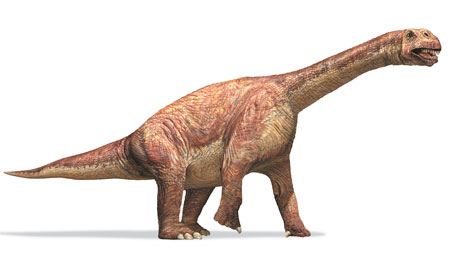 |
| Camarasaurid tooth |
Now scientists have discovered a series of fossil teeth which prove this long standing theory, showing that some species of giant, plant-eating dinosaurs (based upon the species from which the teeth came) migrated hundreds of kilometres on a seasonal basis.
A research team at Thermopolis, Wyoming, and the Dinosaur National Monument, Utah, discovered 32 teeth belonging to the late Jurassic giant Camarasaurus. These creatures could weigh 18 tonnes and be 20 metres in length. Such a massive body requires a vast food source. Most of the day would be spent in eating and digesting. Analysis of the teeth revealed that, to maintain itself, Camarasaurus migrated vast distances, in time with the seasons, to find food.
 |
| An artist's impression of Camarasaurus |
As the enamel layer was regenerated throughout the year, it preserved the ratio in the water that the creature was drinking. Alternating layers of the same ratio means that the creature was living and feeding in two different places at different times in the year. By comparing the results from the teeth with samples of soil from the same layer as the teeth at both fossil sites, the team found that for 5 to 6 months of the year, Camarasaurus in this particular region of America lived in highlands, and for the remainder, was in the lowlands.
The distance between the two fossil sites is 300 kilometres. Such a long trek for these lumbering giants would have been arduous and further analysis of the teeth showed that some died soon after arriving. It is likely that the highlands would have been a summer retreat due to the cooler temperatures and greater rainfall, while the sheltered lowlands would have been favourable in winter. It is likely that hunters would also have migrated, either with the pack or to the homeland in order to feed upon the giants.
'What was up in the highlands food-wise we don't know, the land is weathered away, but the conditions may not have been as hot and dry, and it may even have rained more continuously at the higher elevations,' Fricke said. 'This is a neat example of how we can bring geochemical methods to bear on an issue, how we can learn something about dinosaur behaviour that we can't learn from looking at the morphology of the fossils themselves.'